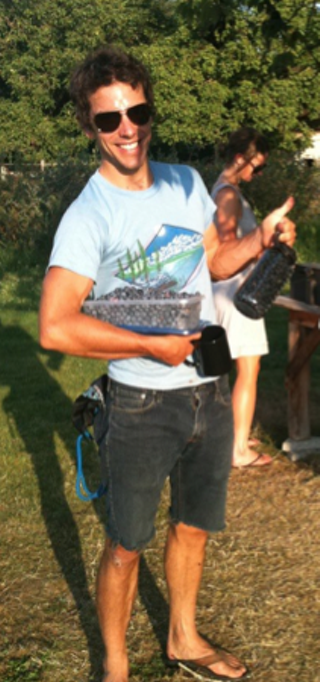Jay Dicharry was not impressed with my tomatoes.
"You got to have good tomatoes to make good sauce," Dicharry told me. "And right now your tomatoes need some work."
I had been running, at various paces, on a treadmill that measures three-dimensional forces. This "instrumented treadmill," which is damn near the most sophisticated treadmill in the world and costs as much as a two-bedroom house on Bend's westside is telling Dicharry that my running form is nothing to brag about. In fact, it kinda sucks—especially at speed.
The new Bend resident and the treadmill's keeper holds a master's degree in physical therapy, is a sports clinical specialist and knows more about the biomechanics of running than most anyone. Anywhere. Ever.
The Louisiana native has coached world-record holders, written a book and lectured worldwide. He now works for Rebound Physical Therapy, which owns the treadmill. A number of major shoe companies, like Merrell, continue to rely on Dicharry for input. These days you can find him skiing the cone, riding Ben's Trail, running along the Deschutes or at Rebound, analyzing athletes on one of the three instrumented treadmills in North America. The other two are in Calgary and Boston.
After administering a thorough clinical session, Dicharry had me run on his uber-treadmill, which is connected to his computer and custom software. As I ran, Dicharry interpreted the myriad data. I could see it, too, as it appeared on a TV screen in front of me. Most of the metrics, measured in units like "meters per second" and "percent of body weight," meant nothing to me at first. But the data meant something to Dicharry.
With just two simple tips, he was able to tell me how to alter my stride to increase efficiency—stand up straighter and kick rather than reach. I also saw real-time feedback on the screen. A graph would show me if I was doing it "right."
After my running test, Dicharry broke the news about my tomatoes, aka my butt and core.
It's not that they're weak, but they don't fire as they should. It's a coordination and timing thing, not a strength thing, Dicharry explained. If I can learn to use my butt while running, I can increase my efficiency by almost 15 percent (fast paces feel easier!) while decreasing my loading rate by 33 percent (less bodily stress!).
My situation is not uncommon. Dicharry is working with Bend's Matt Lieto, one of the Pacific Northwest's top professional triathletes, to make him faster and pain-free. Is it working?
"Yeah, absolutely," Lieto said.
Lieto said he too struggles with deep core issues and has been relearning how to fire his transverse abdominis muscles, the ones that wrap around the sides of your belly.
"It's back to the basics," Lieto said. "I'm working on my core, but to a lesser extent than most people are used to."
Lieto isn't doing planks. Instead, he's relearning how to sit, stand and how to fire his TA at will. This newfound skill should help him with his calf, hip and back issues—and it's treatment that he couldn't get from simple video analysis.
"I used to manage a running shop, and I used to do that stuff," Lieto said. "They can see what's going on directly with the foot, but what Jay [Dicharry] is doing is looking at you structurally. He can do that by reading the data."
Lieto brings up a good point. There are a number places, both locally and nationally, that provide feedback via a video of you on a treadmill. Such information is a step in the right direction, Lieto said, but without objective data, input remains something of an educated guessing game. Plus, such feedback is mostly directed at the foot rather than the whole body.
It's Dicharry's data-driven approach that's led him to work with many of the shoe companies you'll see on the walls of local running shops—Brooks, Mizuno, Newton and Merrell.
"We worked with Jay on a lot of our barefoot products," said Shaun Bohnsack, the category business director for Merrell. "What we're working on is a more natural movement product and that fits in with Jay's philosophy as well."
Dicharry is helping Merrell develop shoes with zero drop, meaning the height at the heel of the shoe is the same as the height at the toe. He's also providing biomechanical testing as well as feedback on materials and the geometry of the shoes.
"His background is quite different," Bohnsack said. "The fact that he is a clinical therapist but also a coach—he can really get to the root of the problem. He's a great asset for us."
Rebound seems to think so as well. Since last summer Dicharry has been helping everyone from college basketball players, professional runners, triathletes and cyclists, to state-champ high school wrestlers and 10-mile-per-week moms and dads.
He's also helping hack runners like me get faster. I now have some simple exercises that should help improve my damn "tomatoes." With good tomatoes I'll be able to make good sauce, i.e., fast, efficient running form—but not until I get my body right. More miles won't do it. Neither will sit-ups, squats, box step-ups or box drops.
Sticking with his analogies, Dicharry offered up a final reminder before I took off: "You can't put a jet engine in a paper plane."
Check.
Running: Three Common Misconceptions
1. Trendy talk: Fast turnover is better (like 180 foot-strikes per minute).
Jay says: "World records have been set at anywhere from 172 to 218 strikes-per-minute. While it's true a lot of novice runners use a low turnover, 180 just isn't true. You have to change constantly and adjust for factors like terrain."
2. Trendy talk: Your feet should land underneath you.
Jay says: "That's kind of impossible. Your feet should strike closer to you. Overstriding is bad."
3. Trendy talk: You should run on your toes.
Jay says: "I don't really care how you run. I'm looking for decreased load and greater efficiency. For me that's a win. It doesn't so much matter if you're a fore, mid or rear-foot striker."
You can find Dicharry's book, Anatomy for Runners: Unlocking your athletic potential for health, speed and injury prevention on amazon.com.






















